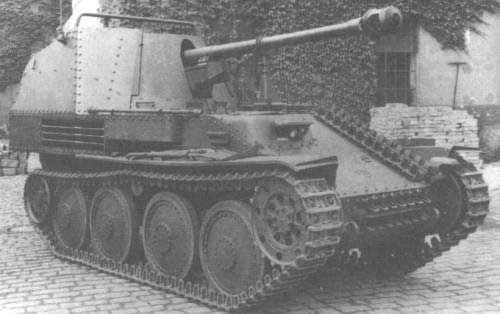Marder l/ll/lll
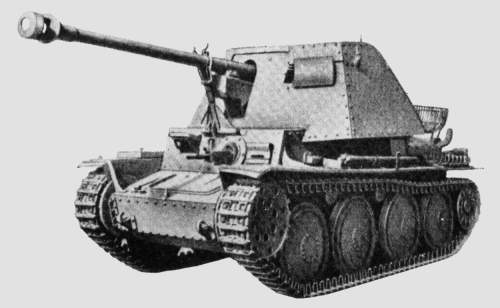
Marder panzers gave artillery mobility
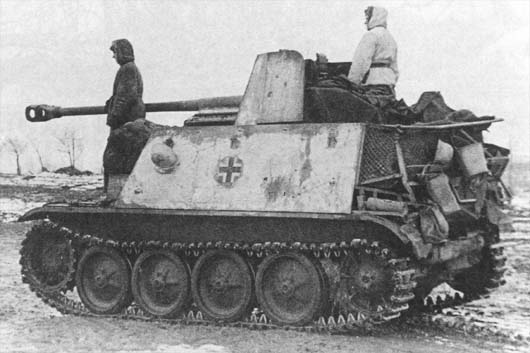
|
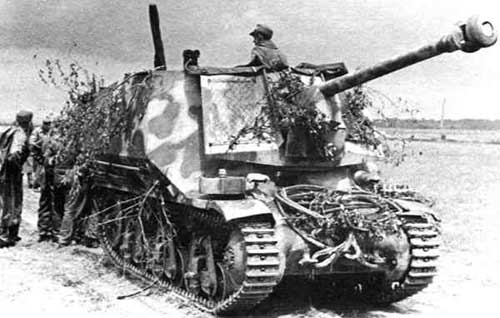
|
| |
Marderpanzer
|
|
Germany's Waffenamt
started development of the Marder series of self-propelled
anti-tank guns in late 1941 to increase the mobility of Pak
(anti-tank) weapons by mounting them on a variety of available
chassis. The Germans saw a need for this vehicle type in the
summer of 1941 with the appearance of new Soviet armored fighting
vehicles, especially the T-34/76 series of medium tanks and
the heavy KV series tanks. It was another "interim solution"
implemented to fill the gaps until more effective and perfected
designs could be developed. Vehicles of the Marder series
were based on proven chassis of obsolete tanks, as well as
on those of captured French tanks. They were armed with either
German-made Rheinmetall-Borsig 75mm PaK 40 series anti-tank
guns, or Soviet 76.2mm F-22 Model 1936 divisional field guns,
which were captured in large numbers in the summer of 1941.
The German 75mm gun was able to penetrate 116mm of armor at
0 degrees with armor-piercing ammunition at the distance of
1,000 meters. Captured Soviet guns were modified by Rheinmetall-Borsig
and rechambered to accept the German 75mm PaK 40 ammunition.
They could penetrate 108mm of armor at 0 degrees at a range
of 1,000 meters using armor-piercing ammunition. In all cases,
the main armament had a limited traverse, forcing the vehicle
to change its position to face the enemy and aim the gun.
In all vehicles, the main armament was fitted with a ZF3x8
telescopic sight. All of these designs were based on the idea
of using and modifying existing components. A high production
output was reached, with 2,812 vehicles manufactured from
April 1942 to May 1944. Vehicles of the Marder series were
not introduced in order as their designations would imply
and Marder II Sd.Kfz.132 was the first of the series. The
entire Marder series suffered from a rather high profile,
making them vulnerable, and their crews were not effectively
protected against anything heavier than small-arms fire. All
vehicles were open at the top and carried canvas covers for
protection from weather during rest and transport. Despite
their disadvantages, they successfully provided Panzer, Panzergrenadier
and Infantry Divisions (issued to Panzerjager Abteilungen)
with mobile and powerful anti-tank weapons (eg, as of 1943,
in theory each Panzerjager Abteilung was equipped with 51
Marder II Sd.Kfz.131/132). The first Waffen SS divisions to
receive the Marder II and III were 1st Leibstandarte SS Adolf
Hitler, 2nd Das Reich, 3rd Totenkopf and 5th Wiking. As a
class, the Marders were eventually replaced by more powerful
purpose-designed panzerjägers, but many Marders remained
in service until the end of the war.
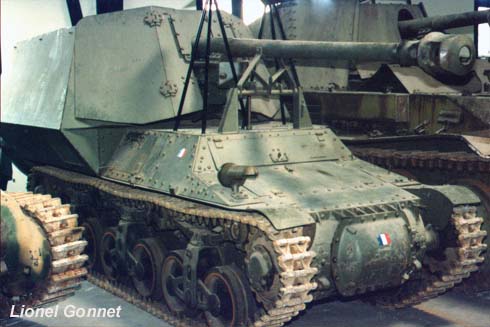
|
In May 1942, the Germans decided to convert a number of captured
French Tracteur Blinde 37L (Lorraine) personnel carriers/artillery
tractors to self-propelled anti-tank guns. They had captured
some 315 new and used vehicles after the fall of France. The
new vehicle was armed with the 75mm PaK 40/1 L/46 anti-tank
gun. This new panzerjäger was designated 7.5cm PaK40/1 auf
Geschutzwagen Lorraine Schlepper(f), SdKfz.135. It was also
known as the Marder I. The conversion replaced the original
transport crew compartment with a new superstructure with
a large gun shield to protect the gun. The lightly-armored
superstructure offered little protection for the five-man
crew. The main armament could be traversed 32 degrees to the
left and right. In addition to the main armament, a 7.92mm
MG 34 was carried inside the fighting compartment. Forty rounds
of ammunition were carried for the main gun. Armor protection
ranged from 5mm to 12mm. One hundred seventy 37Ls were converted
by Captain Alfred Becker's Baukommando in Paris, and at Krefeld
(in cooperation with Alkett in Berlin) in July and August
1942. The 7.5cm PaK40/1 auf Geschutzwagen Lorraine Schlepper(f)
was first issued to Panzerjäger units of Infantry Divisions
on the Eastern Front, but they eventually returned to serve
in France with the occupation forces. In 1943, 12th SS Panzer
Division "Hitlerjugend", then forming in France, received
some three Marder I tank destroyers for training purposes.
Also, 21st Panzer Division's Sturmgeschütz Abteilung 200,
commanded by now Major Alfred Becker, fielded some 24 Marder
Is in the Normandy battles. They proved very effective, and
Allied troops often reported them as self-propelled 88mm anti-tank
guns. In spring 1944, 17th SS Panzer-Grenadier Division "Götz
von Berlichingen" received a company of 12 Marder Is. These
were all lost during the fighting in Normandy. In early 1944,
there were still some 131 in service, and six were still in
use in mid-March 1945. Similar vehicles mounting howitzers
were also used. Both the 10.5cm leFH 18(Sf) auf Gw Lorraine
Schlepper(f) and the 15cm sFH 13/1(Sf) auf Gw Lorraine Schlepper(f)
Sd.Kfz.135/1 were produced in limited numbers.
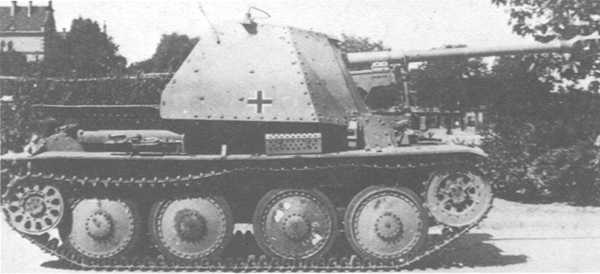
|
| turret.
|
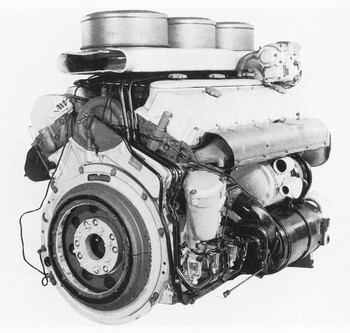
|
The engines for the ....
|
The Germans captured some 600 Hotchkiss
light tanks after the fall of France. In 1942, 24 (some sources
state 60) captured French Hotchkiss H-39 (including at least
one H-35) light tanks were converted to self-propelled anti-tank
guns. The new vehicle was armed with the 75mm PaK 40 L/46
anti-tank gun. The new panzerjäger was designated 7.5cm PaK40(Sf)
auf Geschutzwagen 39H(f). This vehicle, too, was known as
the Marder I. In this conversion, the armament was mounted
in an open-topped fighting compartment. A four-man crew operated
the vehicle. The main armament could be traversed 30 degrees
to the left and right. In addition to the main armament, a
7.92mm MG 34 was carried inside the fighting compartment.
Armor protection ranged from 10 to 34mm. Conversions were
done by Captain Alfred Becker's Baukommando in Paris and at
Krefeld (in cooperation with Alkett in Berlin) as well. New
vehicles served with units stationed in France, including
the 8th Panzerartillerie Abteilung and Sturmgeschütz Abteilung
200, commanded by Major Alfred Becker. Turrets of vehicles
converted to weapon carriers were used in fortifications along
with some tanks dug in as fixed bunkers. Similar vehicles
carried a 105mm howitzer in place of the PaK 40, and were
known as 10.5cm leFH 18(Sf) auf Gw 39H(f)..
The Germans captured some 50 FCM36
medium tanks after the fall of France. In 1943, ten captured
French FCM36 tanks were converted to self-propelled anti-tank
guns armed with 75mm PaK 40 L/46 anti-tank guns. The new vehicles
were designated 7.5cm PaK40(Sf) auf Geschutzwagen FCM(f) and
were also known as Marder I. It had a layout similar to the
other Marder I variants - the main armament was mounted in
an open-topped fighting compartment. A four-man crew operated
the vehicle. Armor protection ranged from 10 to 40mm. Captain
Alfred Becker's Baukommando in Paris and at Krefeld (in cooperation
with Alkett in Berlin) did conversions as in the case of the
other two Marder I variants. They served in France as part
of "Schnelle Brigade West", which was incorporated into the
21st Panzer Division in 1943. It then served with 21st Panzer
Division's Sturmgeschütz Abteilung 200, commanded by Major
Alfred Becker. Similar self-propelled howitzer was also used.
10.5cm leFH 16/18(Sf) auf Gw FCM(f) was also produced in limited
numbers.
|

|
|
Tank
|
|
Specifications
The Marder II was a self-propelled anti-tank gun based
on the obsolete Panzerkampfwagen II Ausf A/B/C and F light
tank. It was armed with the 75mm PaK 40/2 L/46 anti-tank
gun. It was designated 7.5cm PaK40/2 auf Fahrgestell PzKpfw
II (Sf). This conversion used both new and used chassis
and components of the Panzerkampfwagen II light tank,
which at the time, was taken out of active service as
being inadequate in a combat role. The vehicle used the
standard Ausf F hull and superstructure, on which a new
fighting compartment was mounted. A three-man crew operated
Marder II. The vehicle carried 37 rounds of ammunition.
As with other Marders, it offered minimal crew protection,
as its fighting compartment was open at the top and rear.
The main armament could be traversed 32 degrees to the
left and 25 degrees to the right. In addition to the main
armament, a 7.92mm MG 34 was carried inside the fighting
compartment. Armor protection ranged from 5 to 30mm.
From June 1942 to June 1943, FAMO, MAN and Daimler-Benz
produced 576 Marder II vehicles. In addition, 75 were
converted from July 1943 to March 1944. All Marder IIs
were issued to Panzerjäger Abteilungen and served on
all fronts from July 1942 to the end of the war.
There was also an experimental self-propelled anti-tank
gun based on the Panzerkampfwagen II Ausf A/B/C light
tank. It had a superstructure similar to that of the Marder
II and was armed with a 50mm PaK 38 L/60 anti-tank gun
(due to a shortage of 75mm PaK 40 guns). It was designated
5cm PaK38 L/60 auf Fahrgestell Panzerkampfwagen II (Sf)
and very few were made.
Specifications
| Weight: |
10800kg |
| Crew: |
3 men |
| Engine: |
Maybach HL 62 TRM / 6-cylinder
/ 140hp |
| Speed: |
40km/h |
| Range: |
Road: 190km |
| Fuel Capacity: |
200 litres |
| Lenght: |
6.36m |
| Width: |
2.28m |
| Height: |
2.20m |
| Armament: |
75mm Pak 40/2 L/46
1 x 7.92mm MG34 |
| Ammo: |
75mm - 37 rounds
7.92mm - 600 rounds |
| Armor: |
5-30mm |
Marder II / Sd.Kfz.132
Panzer Selbstfahrlafette 1 für 7.62cm PaK36(r)
auf Fahrgestell PzKpfw II Ausf D1 und D2
Marder II (Sd.Kfz.132).
This self-propelled anti-tank gun was based on the Panzerkampfwagen
II light tank, but on the Ausf D/E and Flammpanzer II
variants. It received a designation of Panzer Selbstfahrlafette
1 für 7.62cm PaK36(r) auf Fahrgestell PzKpfw II, Ausf
D1 und D2, but was also known as LaS 762. The Ausf D1
designation was reserved for vehicles based on the Panzerkampfwagen
II Ausf D/E, while the Ausf D2 model was based on the
Flammpanzer II. This Marder II was armed with a captured
Soviet 76.2mm F-22 Model 1936 divisional field gun, designated
as 76.2mm PaK 36(r) L/51 anti-tank gun, and rechambered
to accept German 75mm Pak 40 ammunition. Some guns were
not fitted with a muzzle brake. The fighting compartment
was created by extending the height of the front and sides
of the superstructure, which resulted in a high silhouette.
The main protection for the four-man crew was provided
by an extended gun shield. Thirty rounds of ammunition
were carried. The main armament could be traversed 50
degrees to the left and right. In addition to the main
gun, a 7.92mm MG 34 was carried inside the fighting compartment.
Armor protection ranged from 5 to 30mm. Three redesigned
versions were produced, depending on the chassis used
and the modifications introduced during production. All
varied in gun shield and superstructure design.
Development of Marder II started in December of 1941.
Alkett and Wegmann converted 201 vehicles from April 1942
to June 1943. Marder IIs were issued to Panzerjäger Abteilungen
and served mainly on the Eastern Front from April 1942
to early 1944, when they were taken out of service.
Specifications
| Weight: |
11500kg |
| Crew: |
4 men |
| Engine: |
Maybach HL 62 TRM / 6-cylinder
/ 140hp |
| Speed: |
55km/h |
| Range: |
Road: 220km / Cross-Country:
140km |
| Fuel Capacity: |
200 litres |
| Lenght: |
5.65m |
| Width: |
2.30m |
| Height: |
2.60m |
| Armament: |
76.2mm Pak 36(r) L/51
1 x 7.92mm MG34 |
| Ammo: |
7.62mm - 30 rounds
7.92mm - 900 rounds |
| Armor: |
5-30mm |
Marder III / Sd.Kfz.138
7.5cm PaK40/3 auf PzKpfw 38(t) Ausf H / Panzerjäger
38(t) mit 7.5cm PaK40/3 Ausf M
Marder III Ausf H (Sd.Kfz. 138).
Marder III Ausf M (Sd.Kfz. 138).
The Marder III was produced in two variants - Ausf H and
Ausf M. They were based on the Panzerkampfwagen 38(t)
Ausf H and Ausf M light tank chassis, respectively. They
were designated as 7.5cm PaK40/3 auf PzKpfw 38(t) Ausf
H, and Panzerjäger 38(t) mit 7.5cm PaK40/3 Ausf M. Both
were armed with the 75mm PaK 40/3 L/46 anti-tank gun and
operated by four-man crews. The Ausf H (Heckmotor-rear
engine) had the fighting compartment in a central forward
location, while the fighting compartment of the Ausf M
(Mitte-mid engine) was at the rear. The fighting compartment
of the Ausf H was open at the top and rear, while that
of Ausf M was open only at the top. The Ausf H carried
38 rounds of ammunition, while Ausf M had only 27 rounds.
The main armament could be traversed 30 degrees to the
left and right in the Ausf H and 21 degrees to the left
and right in the Ausf M. Both vehicles also had additional
armament - the Ausf H had a 7.92mm MG 37(t) mounted in
the front hull, and the Ausf M carried a 7.92mm MG 34
or MG 42 inside the fighting compartment. Armor protection
for the Ausf H ranged from 8 to 50mm, while armor for
the Ausf M ranged from 8 to 20mm. Ausf M was the final
variant of the Marder series and was a significant improvement
over previous models, with its lower silhouette, sloped
armour and much more functional fighting compartment.
From November 1942 to April 1943, BMM made 243 Ausf H
models, and an additional 175 vehicles were converted
in 1943. From April 1943 to May 1944, BMM produced 975
Ausf M models. Ausf M was modified during production,
and early and late models can be identified by their unique
features. The Ausf H was first issued to Panzerjäger
Abteilungen in late 1942. They also served with Waffen
SS (e.g. Leibstandarte SS Adolf Hitler in Russia, 1942)
and Luftwaffe (e.g. Herman Goring Division in Tunisia
and Italy, 1943) units. In April 1944, 18 Ausf H were
also exported to Slovakia. Ausf M was first issued to
Panzerjäger Abteilungen in May 1943. It fought on all
fronts, and there were still 350 in service as of February
1st 1945.
The Marder III Ausf H and Ausf M were also used to produce
self-propelled guns armed with 150mm sIG heavy infantry
guns and designated as Grille/Bison Ausf H and Ausf M.
There was also a proposed project to mount a Panzerjäger
38(t) Ausf M with a 75mm PaK L/60 anti-tank gun, but it
was never produced.
In 1945, a number of Marder III Ausf H and Ausf M models
ended up in use by the Czechoslovak Army as ST-II (Stihac
Tanku II).
Specifications
| Model: |
Ausf H |
Ausf M |
| Weight: |
10800kg |
10500kg |
| Crew: |
4 men |
4 men |
| Engine: |
Praga EPA/2 / 6-cylinder
/ 140hp |
Praga AC / 6-cylinder
/ 140hp |
| Speed: |
Road: 35km/h |
Road: 42km/h
Cross-Country: 24km/h |
| Range: |
Road: 240km |
Road: 185km
Cross-Country: 140km |
| Fuel Capacity: |
218 litres |
218 litres |
| Lenght: |
5.77m |
4.95m |
| Width: |
2.16m |
2.15m |
| Height: |
2.51m |
2.48m |
| Armament: |
75mm Pak 40/3 L/46
1 x 7.92mm MG37(t) |
75mm Pak 40/3 L/46
1 x 7.92mm MG34 |
| Ammo: |
75mm - 38 rounds
7.92mm - 1200 rounds |
75mm - 27 rounds
7.92mm - 1200 rounds |
| Armor: |
8-50mm |
8-20mm |
Marder III / Panzerjager 38(t) / Sd.Kfz.139
Panzerjäger 38(t) 7.62cm PaK36(r)
Marder III (Sd.Kfz. 139).
This Marder III was also based on Panzerkampfwagen 38(t)
light tank. It was designated Panzerjager 38(t)
7.62cm PaK36(r), and was armed with a captured Soviet
76.2mm PaK 36(r) L/51 anti-tank gun rechambered to accept
German 75mm PaK 40 ammunition. Some guns were not fitted
with a muzzle brake. The standard Panzerkampfwagen 38(t)
light tank, with its turret and top superstructure removed,
was fitted with a superstructure to form the fighting
compartment for a four-man crew. The fighting compartment
was open at the top and rear, and the slightly extended
gun shield offered the only protection for the crew. The
vehicle carried 30 rounds of ammunition. The main armament
could be traversed 21 degrees to the left and right. In
addition to the main gun, a 7.92mm MG 37(t) was mounted
in the front hull. Armor protection ranged from 10 to
50mm.
From April to November 1942, BMM produced 344 units (177
based on Ausf G and 167 on Ausf H), and an additional
19 were converted in 1943. Marder IIIs were issued to
Panzerjager Abteilungen and served mainly on the Eastern
Front, but 66 were also delivered to North Africa from
July to November 1942. In North Africa, the Marder III
served with the 15th Panzer Division (33rd Panzerjäger
Abteilung) and 39th Panzerjager Abteilung. It proved
to be very effective against British Matilda II tanks,
and was often thought to be a mobile version of the 88mm
gun.
In 1945, a number of Marder III vehicles ended up in use
by the Czechoslovak Army as ST-II (Stihac Tanku).
Marderpanzer Specifications
| Weight: |
10670kg |
| Crew: |
4 men |
| Engine: |
Praga EPA / 6-cylinder
/ 125hp
Praga EPA/2 / 6-cylinder / 140hp |
| Speed: |
42km/h |
| Range: |
Road: 185km / Cross-Country:
140km |
| Fuel Capacity: |
218 litres |
| Lenght: |
5.85m |
| Width: |
2.16m |
| Height: |
2.50m |
| Armament: |
76.2mm Pak 36(r) L/51
7.92mm MG37(t) |
| Ammo: |
7.62mm - 30 rounds
7.92mm - 1200 rounds |
| Armor: |
10-50mm |
The Germans captured
some 50 FCM36 medium tanks after the fall of France. In 1943,
ten captured French FCM36 tanks were converted to self-propelled
anti-tank guns armed with 75mm PaK 40 L/46 anti-tank guns.
The new vehicles were designated 7.5cm PaK40(Sf) auf Geschutzwagen
FCM(f) and were also known as Marder I. It had a layout similar
to the other Marder I variants - the main armament was mounted
in an open-topped fighting compartment. A four-man crew operated
the vehicle. Armor protection ranged from 10 to 40mm.
Captain Alfred Becker's Baukommando in Paris and at Krefeld
(in cooperation with Alkett in Berlin) did conversions as
in the case of the other two Marder I variants. They served
in France as part of "Schnelle Brigade West", which
was incorporated into the 21st Panzer Division in 1943. It
then served with 21st Panzer Division's Sturmgeschütz
Abteilung 200, commanded by Major Alfred Becker.
Similar self-propelled howitzer was also used. 10.5cm leFH
16/18(Sf) auf Gw FCM(f) was also produced in limited numbers.
Marder Panzer Photo Gallery
Contact Webmaster
Mike Kaspar
|
| |
|






